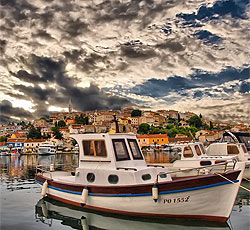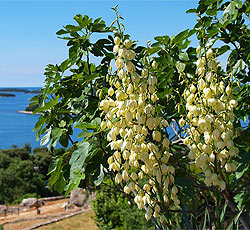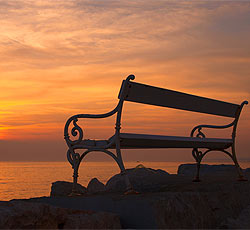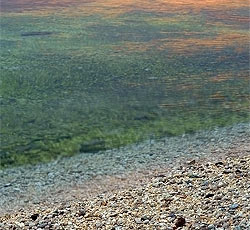-
Vrsar Archipelago (Vrsar, Istria)
It consists of 18 unpopulated green islands and islets, including: Figarolica, Lakal, Salamon, Zavata, Galiner, Sv. Juraj, Gusti skolj, Koversada i Orlandin. -
Giacomo Casanova Street (Vrsar, Istria)
The Italian adventurer and writer Giacomo Casanova stopped in Vrsar twice during the 18th century (in 1743 and 1749) and he wrote about it in his famous memoirs. According to the legend, Casanova did not just spend his summer holidays in Vrsar but took up residence there, so a Vrsar street containing La Casa di Rose, his alleged residence, was named after him. -
The Fkk Beach Koversada (Vrsar, Istria)
The Beach Koversada is situated under the same name camp and touristic settlement. It stretches 5 km along the coast with the various beaches. At the middle sandy beach the access for the people with special needs is arranged. One part of the beach is allowed for the dogs. Near the beach are few fun and recreational contents and is possible to rent deck chairs and umbrellas.
Fkk Beach Koversada Info -
The park of Dušan Dzamonja’s sculptures (Vrsar, Istria)
The protected house and Sculpture Park complex belonging to the greatest Croatian and European contemporary sculptor Dušan Džamonja, whose sculptures are exhibited in the most renowned museums of the world, is spread over an area in Vrsar which provides a view of one of the most beautiful archipelagos in the Mediterranean. The Sculpture Park has contained sculptures, graphics and drawings since 1970. -
Old Romanesque Gate (Vrsar, Istria)
The gate was built in the second half of the 17th century or the first half of the 18th century when the architecture and stone work in the towns of Istria turned to Romanesque style. The gate was included in the town wall system. It contains a fragment of the town walls and tablet with a shallow relief of St. Mark’s lion – a symbol of the Venetian rule.
Old Romanesque Gate Info
Vrsar - przewodnik turystyczny po Vrsar na Istrii
Kultura Vrsar
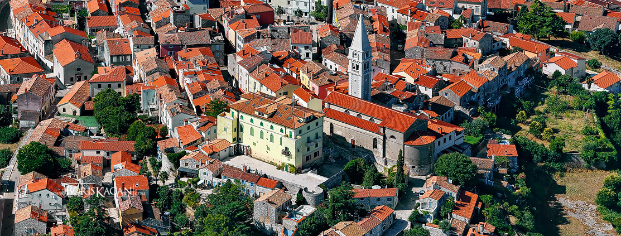 Wąskie, sklepione uliczki starego miasta prowadzą do bramy miejskiej, małych placów, kamiennych domów, malowniczych kościołów i trzech belwederów. Widok na wybrzeże Vrsar jest naprawdę uroczy: najbardziej poszarpana linia brzegowa na Istrii ozdobiona jest przez jeden z najpiękniejszych śródziemnomorskich archipelagów, w których znajduje się 18 niepopularnych wysp otaczających krystalicznie czyste Morze Adriatyckie. Vrsar może być dumne ze swojej barwnej historii, która sięga okresu prehistorycznego. Od wieków znane jest ze źródeł wody pitnej, dzięki czemu uzyskało starożytną nazwę Ursaria (stare śródziemnomorskie słowo "ur" lub "wiosna"), a także pobliskiego miejsca Funtana (fontanna). To również miejsce przeznaczenia dla tych, którzy szukają odpoczynku i odświeżenia. Warto wspomnieć, że nawet włoski poeta i poszukiwacz przygód Giacomo Casanova spędzał romantyczne lata w Vrsarze w latach 1743 i 1744. Wspominał o mieście w swoich słynnych wspomnieniach. Ze względu na produkcję soli, Vrsar jest oznaczony na mapach starego świata, a na jego ulicach można znaleźć wysokiej jakości szary kamień, który był używany w budynkach Wenecji, w całym Cesarstwie Rzymskim. Vrsar jest uznane za miasto rzeźbiarzy. Jest to miejsce słynnego parku rzeźby Dušan Džamonja. W mieście można znaleźć kamienne rzeźby, a ich liczba wzrasta każdego roku po regularnych wizytach międzynarodowej kolonii rzeźbiarskiej Montraker. Obszar wokół Vrsar jest bogaty z winorośle i gaje oliwne oraz muszle i inne morskie przysmaki hodowane w pobliskim chronionym parku przyrody Lim Channel, co czyni Vrsar jednym z preferowanych miejsc dla smakoszy i miłośników wina. Turystyka jest ważnym ogniwem w gospodarce Vrsar, a miasto zostało kilkakrotnie ogłoszone jako najlepsze miejsce turystyczne Chorwackiego Adriatyku. Vrsar jest miejscem wypoczynku dla wszystkich, którzy lubią aktywnie spędzać wakacje, a także dla rodzin. Dziś Vrsar jest również znane z dużej przystani, w pobliżu Koversada, największego ośrodka przyrodniczego.
Wąskie, sklepione uliczki starego miasta prowadzą do bramy miejskiej, małych placów, kamiennych domów, malowniczych kościołów i trzech belwederów. Widok na wybrzeże Vrsar jest naprawdę uroczy: najbardziej poszarpana linia brzegowa na Istrii ozdobiona jest przez jeden z najpiękniejszych śródziemnomorskich archipelagów, w których znajduje się 18 niepopularnych wysp otaczających krystalicznie czyste Morze Adriatyckie. Vrsar może być dumne ze swojej barwnej historii, która sięga okresu prehistorycznego. Od wieków znane jest ze źródeł wody pitnej, dzięki czemu uzyskało starożytną nazwę Ursaria (stare śródziemnomorskie słowo "ur" lub "wiosna"), a także pobliskiego miejsca Funtana (fontanna). To również miejsce przeznaczenia dla tych, którzy szukają odpoczynku i odświeżenia. Warto wspomnieć, że nawet włoski poeta i poszukiwacz przygód Giacomo Casanova spędzał romantyczne lata w Vrsarze w latach 1743 i 1744. Wspominał o mieście w swoich słynnych wspomnieniach. Ze względu na produkcję soli, Vrsar jest oznaczony na mapach starego świata, a na jego ulicach można znaleźć wysokiej jakości szary kamień, który był używany w budynkach Wenecji, w całym Cesarstwie Rzymskim. Vrsar jest uznane za miasto rzeźbiarzy. Jest to miejsce słynnego parku rzeźby Dušan Džamonja. W mieście można znaleźć kamienne rzeźby, a ich liczba wzrasta każdego roku po regularnych wizytach międzynarodowej kolonii rzeźbiarskiej Montraker. Obszar wokół Vrsar jest bogaty z winorośle i gaje oliwne oraz muszle i inne morskie przysmaki hodowane w pobliskim chronionym parku przyrody Lim Channel, co czyni Vrsar jednym z preferowanych miejsc dla smakoszy i miłośników wina. Turystyka jest ważnym ogniwem w gospodarce Vrsar, a miasto zostało kilkakrotnie ogłoszone jako najlepsze miejsce turystyczne Chorwackiego Adriatyku. Vrsar jest miejscem wypoczynku dla wszystkich, którzy lubią aktywnie spędzać wakacje, a także dla rodzin. Dziś Vrsar jest również znane z dużej przystani, w pobliżu Koversada, największego ośrodka przyrodniczego. 